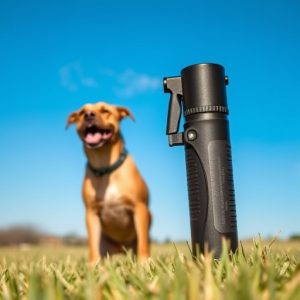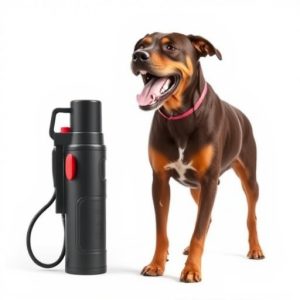Dog Attack Spray: Regulatory Aspects & Effective Self-Defense Strategies for Pet Safety
Self-defense sprays for dog attacks are effective tools, but navigating regional regulations is vita…….
Self-defense sprays for dog attacks are effective tools, but navigating regional regulations is vital for responsible pet ownership and legal compliance. Laws govern who can possess and use these sprays, with varying restrictions on type, strength, and permitted uses to protect pets and bystanders. Understanding animal behavior through training remains paramount alongside spray usage as a last resort. Effective deployment targets the dog's face and eyes, allowing safe retreat, but de-escalation techniques should be prioritized first.
“In today’s diverse and often unpredictable world, understanding self-defense tools like dog attack spray is crucial for personal safety. This comprehensive guide explores the intricate details of self-defense aerosols, focusing on their effectiveness against canine aggressors. We delve into the legal framework surrounding these sprays, ensuring you’re aware of the regulations that govern their possession and use. Additionally, we examine pet ownership responsibilities and safe handling practices to foster a balanced approach to personal defense, especially in areas where pets are prevalent.”
- Understanding Dog Attack Spray: An Overview of Self-Defense Aerosols
- Regulatory Framework: Legal Considerations for Personal Defense Sprays
- Pets and Safety: Navigating Responsibilities and Permitted Usage
- Effective Self-Defense Strategies: When and How to Deploy Dog Attack Spray
Understanding Dog Attack Spray: An Overview of Self-Defense Aerosols
Dog attack spray, also known as self-defense aerosols, is a crucial tool for individuals seeking to protect themselves against aggressive dogs. This innovative product delivers a potent solution in a quick and discrete manner, offering users a chance to escape potentially dangerous situations. The spray uses specialized chemicals that temporarily incapacitate the dog, providing enough time for the target to retreat or seek safety.
Understanding the mechanics of dog attack spray is essential, especially considering varying Self Defense Spray Regulations across regions. These regulations often dictate the type and concentration of chemicals used, as well as the conditions under which such sprays can be legally carried and deployed. Knowing your rights and responsibilities regarding pet safety and self-defense is paramount. With proper knowledge, individuals can ensure they use these aerosols responsibly while adhering to local laws, thereby fostering a safer environment for both pets and people alike.
Regulatory Framework: Legal Considerations for Personal Defense Sprays
The regulation of self-defense sprays, including those designed for protecting against dog attacks, varies significantly across different jurisdictions. This regulatory framework is a critical aspect to consider when evaluating the legality and accessibility of such products for personal defense. Many countries have specific laws governing the sale, possession, and use of pepper spray or other similar irritants aimed at deterring potential threats, including aggressive animals. These legal considerations often involve licensing requirements, age restrictions, and permitted uses.
When it comes to pet safety, some regions have implemented unique regulations. For instance, certain areas may allow citizens to carry dog attack sprays under specific conditions, such as when walking in known high-risk areas or during activities like hiking or camping where encounters with aggressive dogs are more probable. However, there might be restrictions on the type and strength of spray permitted, ensuring that they do not cause unnecessary harm to animals or bystanders. Understanding these regulations is essential for responsible pet owners who seek to protect themselves and their pets from potential dangers posed by unprovoked dog attacks.
Pets and Safety: Navigating Responsibilities and Permitted Usage
When it comes to pets and safety, especially concerning self-defense spray, navigating responsibilities and permitted usage is crucial. It’s important to remember that while self-defense sprays can be a tool for protecting oneself against dog attacks, they are subject to regulations that vary by region. As pet owners, it’s our responsibility to understand and adhere to these laws to ensure the safety of both our pets and others.
Each area has specific guidelines on who can possess and use such sprays, typically focusing on ensuring they’re used responsibly and only as a last resort. These regulations exist to maintain public safety while acknowledging the unique challenges pet owners face. Remember, proper training and understanding of animal behavior are often more effective in preventing and managing potential attacks than relying solely on spray.
Effective Self-Defense Strategies: When and How to Deploy Dog Attack Spray
In situations where a dog attack becomes inevitable, having self-defense spray on hand can be a lifesaver. When deployed correctly, dog attack spray can create enough distance to escape or stun the assailant, allowing for a safe retreat. It’s crucial to understand the regulations around carrying and using self-defense spray, especially when it comes to pets. Many areas have specific rules regarding the type of spray permitted, its strength, and where it can be carried. Always check local laws and ensure your spray meets these requirements to avoid legal repercussions.
The timing and method of deployment are key. When faced with an aggressive dog, aim for the face and eyes—this area is sensitive and can quickly disable the animal. Release the spray in a sweeping motion to cover both you and the dog, creating a barrier that allows you to move away safely. Remember, self-defense spray is a tool of last resort; de-escalate the situation if possible by making yourself appear larger, loud noises, or using objects as barriers.
Dog attack spray, a powerful self-defense tool, offers individuals an extra layer of protection against potential dog attacks. However, it’s crucial to understand and adhere to local regulations regarding its possession and usage, especially when considering the well-being of our pets. By familiarizing ourselves with legal guidelines and employing effective self-defense strategies, including proper deployment techniques, we can enhance our safety while coexisting harmoniously with our furry friends. Staying informed about Self Defense Spray Regulations and prioritizing Pets’ safety is key to ensuring a secure environment for all.

